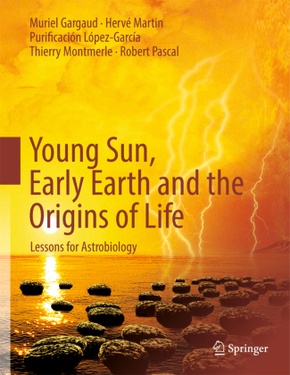Young Sun, Early Earth and the Origins of Life - Lessons for Astrobiology
| Verlag | Springer |
| Auflage | 2013 |
| Seiten | 301 |
| Format | 19,2 x 1,9 x 25,9 cm |
| Gewicht | 662 g |
| Artikeltyp | Englisches Buch |
| Übersetzer | Storm Dunlop |
| ISBN-10 | 3642225519 |
| EAN | 9783642225512 |
| Bestell-Nr | 64222551A |
- How did the Sun come into existence?
- How was the Earth formed?
- How long has Earth been the way it is now, with its combination of oceans and continents?
- How do you define "life"?
- How did the first life forms emerge?
- What conditions made it possible for living things to evolve?
All these questions are answered in this colourful textbook addressing undergraduate students in "Origins of Life" courses and the scientifically interested public. The authors take the reader on an amazing voyage through time, beginning five thousand million years ago in a cloud of interstellar dust and ending five hundred million years ago, when the living world that we see today was finally formed. A chapter on exoplanets provides an overview of the search for planets outside the solar system, especially for habitable ones.
The appendix closes the book with a glossary, a bibliography of further readings and a summary of the Origins of the Earth and life in fourte en boxes.
Inhaltsverzeichnis:
Formation of the Sun and the planets.- Formation and Early Childhood of the Earth.- Water, Continents and Organic Matter.- Intermezzo: Gestation of Life and its First Steps.- Late Bombardment.- Messages from the Most Ancient Terrestrial Rocks.- Diversification of Life on Planet Earth.- Exoplanets and habitability of planets.- Epilogue.- Classification of Rocks.
Rezension:
From the reviews:
"This book is a great source of information that nicely links up everything that you need to know about in astrobiology, and it's accompanied by many schematics and illustrations that help a lot in understanding the text, as well it comes with a very helpful glossary in the end of the book." (Kadri Tinn, AstroMadness.com, February, 2014)
"The book focuses on the chronology of events that led to the appearance of life on Earth, from the formation of the solar system by inert matter 4,57 billion years (4.57 Ga) ago to the Cambrian explosion of lifeforms, 540 million years ago, when the living world that we see today was finally formed. ... The colorful new. amazing textbook is intended for undergraduate students of any field of natural sciences and engineering, and for any scientifically interested reader at all." (Claudia-Veronika Meister, zbMATH, Vol. 1279, 2014)

